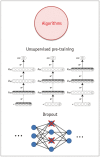Deep Learning in Medical Imaging: General Overview
- PMID: 28670152
- PMCID: PMC5447633
- DOI: 10.3348/kjr.2017.18.4.570
Deep Learning in Medical Imaging: General Overview
Abstract
The artificial neural network (ANN)-a machine learning technique inspired by the human neuronal synapse system-was introduced in the 1950s. However, the ANN was previously limited in its ability to solve actual problems, due to the vanishing gradient and overfitting problems with training of deep architecture, lack of computing power, and primarily the absence of sufficient data to train the computer system. Interest in this concept has lately resurfaced, due to the availability of big data, enhanced computing power with the current graphics processing units, and novel algorithms to train the deep neural network. Recent studies on this technology suggest its potentially to perform better than humans in some visual and auditory recognition tasks, which may portend its applications in medicine and healthcare, especially in medical imaging, in the foreseeable future. This review article offers perspectives on the history, development, and applications of deep learning technology, particularly regarding its applications in medical imaging.
Keywords: Artificial intelligence; Computer-aided; Convolutional neural network; Machine learning; Precision medicine; Radiology; Recurrent Neural Network.
Figures









References
-
- Murphy KP. Machine learning: a probabilistic perspective. 1st ed. Cambridge: The MIT Press; 2012. p. 25.
-
- Byvatov E, Fechner U, Sadowski J, Schneider G. Comparison of support vector machine and artificial neural network systems for drug/nondrug classification. J Chem Inf Comput Sci. 2003;43:1882–1889. - PubMed
Publication types
MeSH terms
LinkOut - more resources
Full Text Sources
Other Literature Sources

